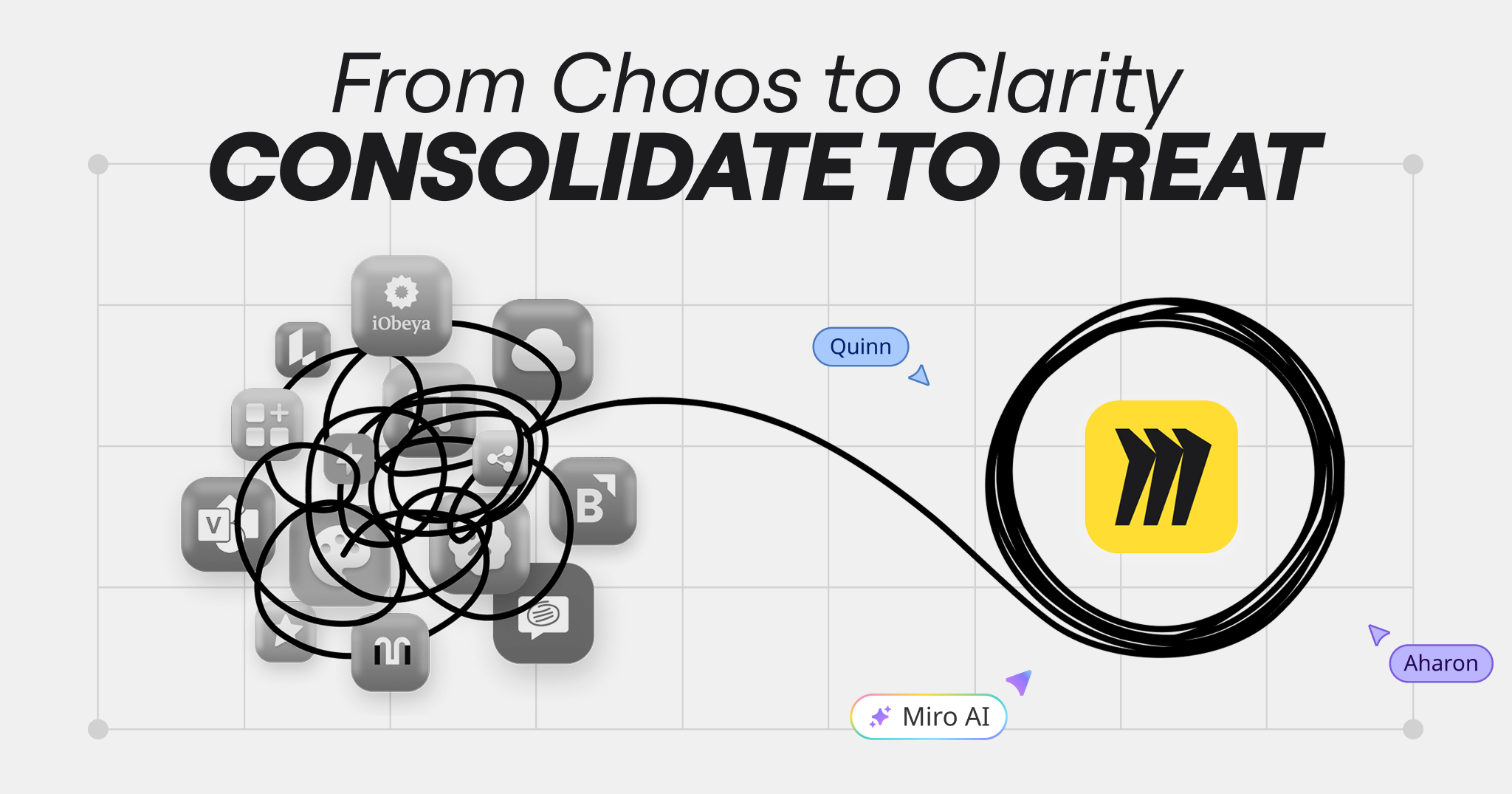I’ve built my 20-plus-year career through continuous learning. I’m intensely curious about people and technology, and the way people experience technology and the world around them. This curiosity has fueled a learner’s mindset that urges me to always want to know what’s next.
So, needless to say, I was fascinated to discover data from Miro’s new Soft Skills Report showing that an overwhelming 97% of knowledge workers today agree that learning a new skill can help them “recession-proof” their jobs, with 89% planning to learn a new skill this year. Reskilling and upskilling is also a popular topic among the enterprise leaders with whom I engage on a daily basis.
The truth is that this period of economic uncertainty isn’t the only reason that skill development is top-of-mind for employers and employees alike. Paired with the pandemic, today’s macroeconomic environment simply amplified a workplace trend that has long been building: The super specialized, technical skills we’ve focused on developing in recent decades won’t continue to serve us nor our organizations well going forward. Rather, cultivating human skills — including relationship building, empathy, creativity, and adaptability — will be essential for keeping up with the already rapid pace of change that new technologies continue to accelerate.
And yet, as important as it is to understand what skills we need to learn, how we learn these skills is the differentiator between passive understanding and active application that drives productivity and business growth. In order to create an adaptable, future-ready workforce, organizations must approach learning and development (L&D) in new ways. Let’s dive deeper into four steps leaders can take to evolve their L&D strategy and ensure the right skills for their people in the future.
1. Recognize L&D as a strategic priority
One of the primary reasons for organizations’ lack of investment in L&D is that it gets lost among HR’s ever-growing list of responsibilities. Not only do these priorities compete for resources (money and time) — some also have conflicting goals. For example, policies focused on regulatory compliance and risk mitigation are often at odds with programs designed to foster employee well-being.
One potential solution is to elevate your L&D leadership into C-suite conversations — treating L&D as a key component of your organization’s talent strategy and differentiating it from HR functions. Slalom does this by creating strong business alignment to key value streams. This year, Slalom prioritized L&D as a top initiative for our people, embedding it into our customer engagement, consulting delivery, and technology strategies.
L&D remains under the HR umbrella with Miro, but leaders have likewise threaded it throughout the company’s culture in the form of one of its core values: “learn, grow, and drive change.” During the hiring process for any role, the values interview is key to not only identifying people who can adapt to and iterate within today’s ever-evolving world of work, but also to growing a workforce that is bought into the company’s learning environment from the outset.
Whether you lead a consulting firm, a SaaS startup, or any other organization, your people are your most valuable asset, and investing in their development is a strategic imperative.
2. Facilitate opportunities for collaborative learning
Buying into L&D as a strategic priority means much more than growing the library of self-serve trainings that you require your employees to complete throughout the year. These rote readings and videos are designed for self-learners, neglecting those who learn best by doing or working alongside others. To foster a more effective and inclusive learning environment, introduce programs and tools that forge connections between colleagues and facilitate on-the-job training.
For example, at Slalom we offer opportunities for junior-level employees to shadow senior leaders, with whom they meet regularly to discuss their growth goals. Leaders enable their “shadow” to sit in on client engagements and spend time debriefing on learnings from those conversations. There’s no requirement to participate, so it tends to be self-directed and attracts people who are dedicated to their own development, of course, but also to helping others progress. The dynamic in these pairings goes beyond that of a typical “mentor” and “mentee” — the insights flow in both directions, fostering a collaborative learning environment that encourages co-creation and growth.
“The majority of learning happens while trying, experimenting, succeeding and failing, and learning from experts. The more we can learn on the job from others, the better and faster our people grow and develop.”
KEITH HILDESHEIM, Sr. Director, People Experience & Talent Management at Slalom
The program’s fluid structure also facilitates ongoing learning — the pairs can continue to collaborate, whether or not they’re consistently in the same office. Such flexible learning is possible, in large part, to tools that encourage transparency and collaboration. In fact, my co-author, Bram, and I discussed how being a co-creator on or simply included in a Miro board facilitates our on-the-job learning. We see ideas grow in the form of our collaborators’ sticky notes, Talktrack recordings, and other contributions and, in the process, gain insight into how they frame problems, tackle challenges, celebrate wins, and more. We can then adopt, adapt, and apply these learnings to the ways that we approach our own projects.
In this way, L&D has progressed from a largely solo, rather static experience into a collaborative exercise. Seeing people work and grow together in online workspaces motivates others to participate, creating a positive feedback loop that, in turn, pulls in additional contributors eager to learn and share their learnings.
3. Create a continuous learning environment
Evolving the continuous learning loops described above into a full-fledged continuous learning environment requires leaders to realize the importance of and invest in their own learning and development. This often isn’t as simple and straightforward as it sounds, given that many leaders rise to such high levels based on what they know. That said, there are a few steps that you can take to recast yourself as a learner and leader.
First, organizations can create structures that facilitate dialogue among leaders about trends shaping their teams, businesses, and industries. To this end, Slalom strives to break down geographic silos by bringing together leaders who do similar types of work across the firm to share what’s working and what’s not in their specific markets. Leaders and practitioners meet virtually or in-person monthly to share stories, successes and best practices, as well as problem solve together. Miro, meanwhile, coordinates community groups — including Miro Consultants and Miro Enterprise Advocates — to foster connections between leaders across companies and industries.
While leaders are often already well trained on the hard skills and technologies specific to their business areas, everyone can benefit from formal leadership training on how to grow themselves and their teams. Organizations may offer access to peer / professional coaching and group workshops to help managers keep these soft skills fresh, or they may opt to provide leaders with resources to seek out such trainings themselves.
By embracing a learning mindset, you open yourself up to new possibilities that allow you to think beyond the world of work as it is today and envision what it, and your company, could become. Investing in your own development, alongside that of your workforce, is akin to investing in your company’s ability to adapt to and innovate in the ever-changing, fast-moving future of work.
4. Adopt an AI-powered approach to L&D
The recent ubiquity of generative AI technology has made many leaders feel like the future is now. And, when it comes to learning and development, it is.
Though AI cannot wholly replace the human capabilities on which modern workplaces run, there are several ways that AI can streamline skill development:
- By processing data from performance reviews on delivery quality and volume, for example, AI can identify high-performers and where they sit within an organization — in addition to uncovering skills gaps.
- It can also generate a snapshot of the organization’s current L&D landscape, tracking trends in how people are currently learning and uncovering opportunities for new types of trainings.
- AI can match coaches and mentees based on shared experiences and interests, as well as connect learners with relevant educational material in real-time.
You can then turn these AI outputs, which are valuable in their own right, into truly transformative outcomes for your organization by leveraging them to devise a scalable strategy for re- and up-skilling your existing workforce. At Slalom, we take a fiercely human approach with our learning ecosystem — leveraging emerging technologies to develop lifelong learning behaviors, critical thinking, and mental agility.
Far from being the shortcut it’s often perceived as, AI is a solution that leaders can leverage to scale L&D across their organizations. And, on an individual level, the ideas it generates can enrich and strengthen people’s critical thinking by requiring users to determine the accuracy and relevancy of its output. In these ways, AI serves as a multi-purpose teacher and tool.
READ MORE: TALENT STRATEGY IN THE AGE OF AI
Investing in L&D now can yield dividends in the future
There’s no doubt that learning and development is a pivotal pillar of a company’s talent strategy — investing in the re- and up-skilling of your workforce makes for more creative, productive, and satisfied employees. In fact, LinkedIn’s new Global Talent Trends report shows that companies whose employees learn skills on the job see a 7% higher retention rate at the three-year mark.
What’s more, L&D is increasingly critical to a successful business strategy. Investing in the upskilling of our early career consultants and continuous learning of all our consultants through in-house L&D programs, hands-on learning experiences, and external certifications and coursework enables Slalom to (typically) double our impact in sales and client delivery.
Supercharge your own organization’s ability to adapt, grow, and pivot as new technologies emerge and the workforce evolves with L&D.





